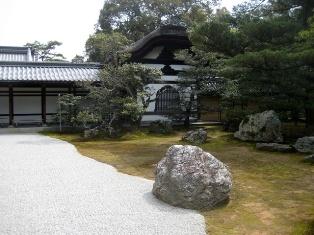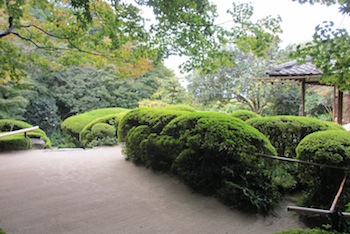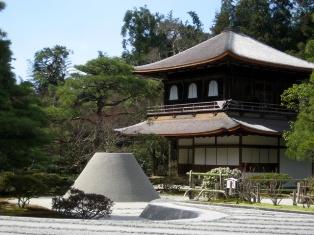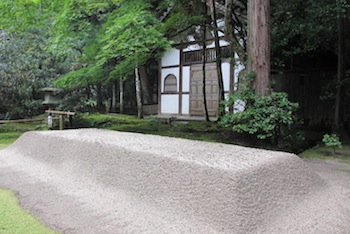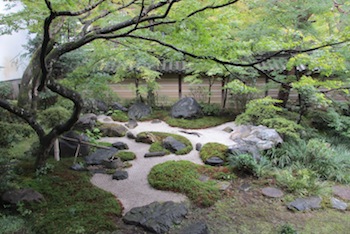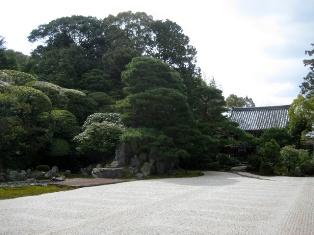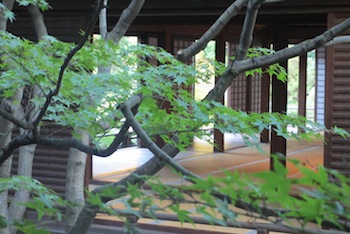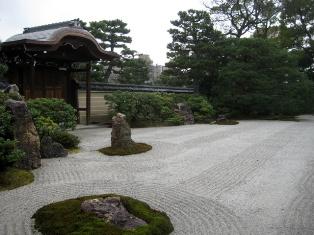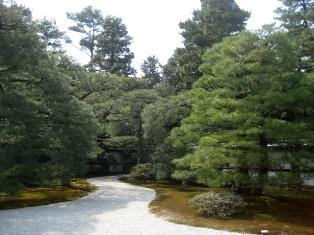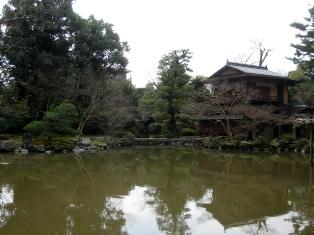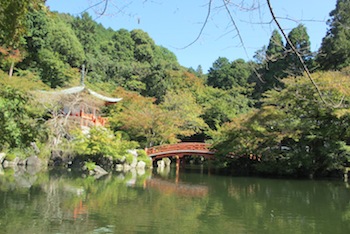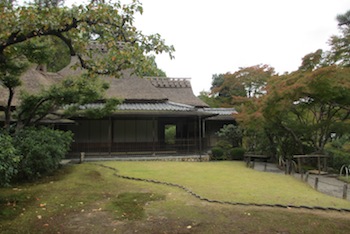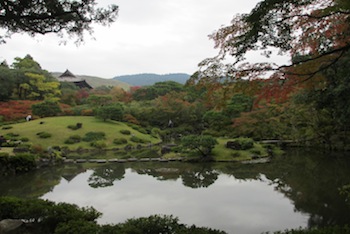Kyoto is absolutely packed with fine Japanese gardens, needless to say a must visit in any Japan itinerary. The gardens, often part of temples or old imperial retreats, are spread around the city (with the exception of Daitoku-ji, which is a large complex housing several temples).
Unfortunately, most gardens get crowded on afternoons, especially in the weekends. The gardens are particularly beautiful in November, with the colorful autumn colors. Rent a bike to get around easily.
Map of Japanese gardens in Kyoto

Open this map on Google maps: Japanese gardens in Kyoto
Japanese gardens in Kyoto
1) Ninna-ji (Kyoto)
仁和寺
A Kyoto highlight, Ninna-ji is absolutely gorgeous. Founded in 886 as an imperial villa, it was later converted into a Buddhist temple. The main temple features several impressive buildings and large separated gardens. In the background of the second garden you will find the five-storey pagoda.
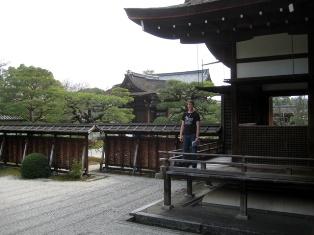
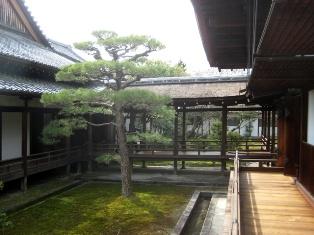
How to get there:
Ninna-ji is accessible from Kyoto station (bus 26) and from Keihan Sanjo station (bus 59). The garden is open year round, from 9:00 to 16:30. Entrance fee: free to visit the temple grounds, the garden entrance is 500 Yen.
Ninnaji address: 33 Omuro Ouchi Kyoto, Kyoto (Tel. 75-461-1155)
02) Ryoanji (Kyoto)
竜安寺 & 龍安寺
Ryoan-ji’s famous kare-sansui garden (at the back of the temple’s park) is thought to date from the 15th century. Although the garden gets completely packed (unless you visit when it opens during weekdays), the garden is still impressive and a must-visit. The garden’s fifteen moss covered rocks are placed so that, when looking at the garden from any angle, only fourteen are visible. The surrounding park is less crowded and nice to walk around on sunny days.
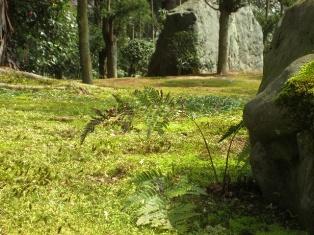
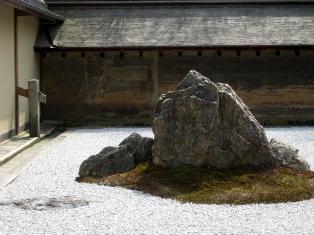
How to get there: Ryoan-ji is located relatively close to Kinkaku-ji, by foot it takes about half an hour. Alternatively, take a bus from Kinkaku-ji or bus 59 from Keihan Sanjo Station. The garden is open daily, from 8am-5pm (until 4.30pm Dec-Feb). Entrance fee: 500 Yen.
Ryoanji address: 13 Ryoanji Goryonoshita-cho, Ukyo-ku, Kyoto (Tel. 075 463 2216)
Official website: www.ryoanji.jp
3) Kinkaku-ji Golden pavilion (Kyoto)
金閣寺
Kyoto’s most famous sight, the golden pavilion attracts large crowds at all days. Originally built as a retirement villa for the Shogun, it was later converted into a temple. The current building dates from 1955 (rebuilt after being burned down completely). The pond garden in front of Kinkakuji dates from the 13th century and is beautiful, although the large crowds diminish the pleasure of visiting somewhat. If you go, do it first thing in the morning and not on weekends.
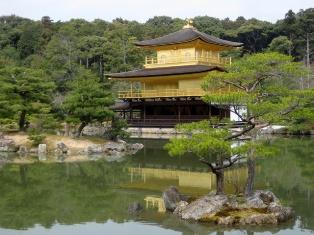
How to get there: To get to Kinkaku-ji temple, take bus 205 from Kyoto station and get off at Kinkakuji michi bus stop. The garden is open year round from 9 to 5. Entrance fee: 400 Yen.
Kinkakuji address: 1 Kinkaku-ji-cho Kita-ku, Kyoto 603-8361 (Tel. 075-461-0013)
Official website: www.shokoku-ji.or.jp/english/e_kinkakuji
4) Daitoku-ji
大徳寺
Home to 22 sub temples, Daitokuji is a large temple complex in northern Kyoto, packed with stunning gardens. To get to the complex, take bus 205 or 206 from Kyoto station and get off at Daitoku-ji bus stop. Alternatively, take the subway to Kitao-ji station.
The following four sub temples have interesting gardens open to visit;
a) Daisen-in (part of Daitoku-ji complex, Kyoto)
大仙院
Daisenin has a large kare-sansui (rock garden), but is particularly famous for its two small side gardens. Several typical dry garden elements can be found here; a mountain (Mount Horai), crane and turtle islands and a dry waterfall. The main hall of Daisen-in is encircled by a dry river, ‘flowing’ clockwise starting from the northeastern corner. Try visit the temple early in the morning as it gets crowded. The friendly staff speaks English and can explain some of the garden’s meanings. Taking pictures is normally not allowed.
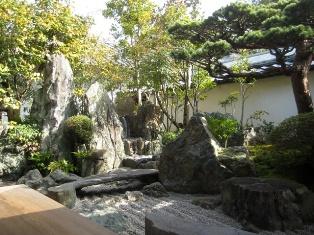
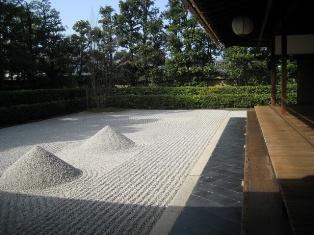
How to get there: Daisen-in is located in the northeastern corner of Daitoku-ji temple complex. The garden is open year round from 9:00 to 5:00 Mar – Nov; 9:00 – 4:30 in Dec-Feb. Entrance fee: 400 Yen.
Daisen-in address: Kita-ku, Murasakino, Daitokuji-cho (Tel. 075-491-8346).
b) Koto-in (part of Daitoku-ji complex, Kyoto)
高桐院
Kotoin’s entrance is lined by bamboo plants, welcoming you into the main garden. Though perhaps not as refined as other gardens, the several maple trees and other garden elements surely make for a beautiful setting (especially in summer and autumn).
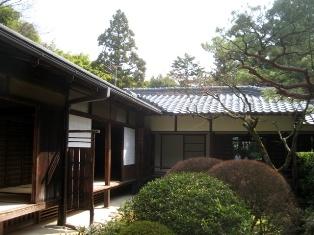
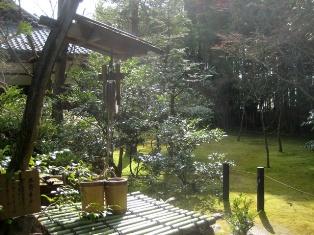
How to get there: Koto-in is located on the western side of Daitoku-ji temple complex. The garden is open year round from 9:00 to 4:30. Entrance fee: 400 Yen.
Koto-in address: 73-1 Daitokuji-cho Murasakino, Kita-ku, Kyoto 603-8231 (Tel. 75 492 0068)
c) Ryogen-in (part of Daitoku-ji complex, Kyoto)
龍源院
My personal Daitoku-ji highlight, Ryogenin is home to four superb gardens. The most famous is the expansive moss garden (Ryogin-tei), laid out in the 16th century. The rock garden (Isshidan) has been established more recently, but is absolutely stunning.
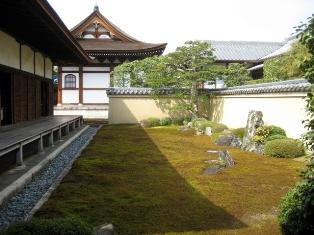
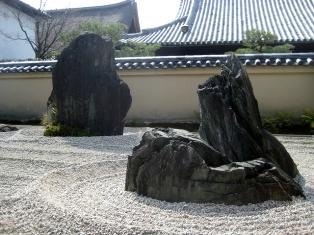
How to get there: Ryogen-in is located on the southern side of Daitoku-ji temple complex. The garden is open year round from 9:00 to 4:30. Entrance fee: 350 Yen.
Ryogenin address: 82-1 Daitokuji-cho, Murasakino, Kita-ku, 603 Kyoto (Tel. 75 491 7635)
d) Zuiho-in (part of Daitoku-ji complex, Kyoto)
Zuihoin was closed when I visited the temple complex, but is without doubt interesting to visit. Its karesansui is quite modern (it dates from 1961, designed by Shigemori).
5) Shisen-do (Kyoto)
詩仙堂
This Buddhist temple (head of the Soto Zen sect) dates back to 1641. It is one of the most beautiful (but less famous) gardens of Kyoto, making it a must visit as you will have the chance to be alone in the garden. Go here in the morning to really appreciate its beauty. A great time to visit the garden is when the Azaleas bloom (early summer).
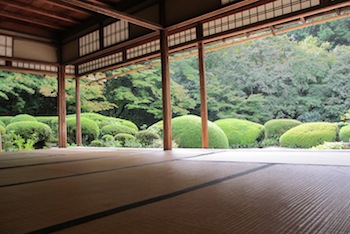
How to get there: The garden is a bit remote, but the JR station “ichijoji” is not too far away. Taking a taxi, or renting a bike is probably the best way to visit. Open daily 9:00 -17:00.
Shisendo address: 27 Ichijoji Monguchicho, Sakyo Ward, Kyoto, Kyoto Prefecture 606-8154 (tel: +81 75-781-2954)
6) Ginkaku-ji Silver pavilion (Kyoto)
銀閣寺
This famous Zen temple was initially built to serve as a retirement villa, modeled as a silver version of the golden pavilion Kinkakuji (though the plans to cover the temple in silver were never realized). When entering the temple precinct the first thing you are likely to encounter is the iconic cone-shaped pile of sand (symbolizing Mount Fuji) on the edge of the karesansui (dry garden).
The garden surrounding the temple is supposedly designed by the well-known landscape artist Sōami and is simply stunning (and labor intensive, as the dry garden is re-raked every day). Arrive early in the morning or just before closing as enjoying a Zen garden together with over a hundred other visitors will be difficult.
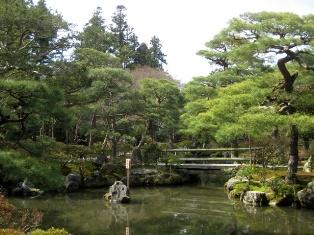
How to get there: Bus numbers 5, 17 and 100 serve Ginkaku-ji from Kyoto Station. The Path of Philosophy connects the temple with Nanzen-ji. The garden is open year round, from 8:30 to 17:00 (9:00 to 16:30 from December to February). Entrance fee: 500 Yen.
Ginkakuji address: 2 Ginkakuji-cho Sakyo-ku, Kyoto 606-8402 (Tel. 075-771-5725)
Official website: www.shokoku-ji.or.jp/english/e_ginkakuji
7) Honen-in
法然
You can walk here from Ginkakuji and you’ll be sure to see much less visitors here. The temple is much more secluded and has a stunning entrance path, leading up to the temple. Its rather small though, but definitely worth a visit if you pass by.

How to get there: Take the Kyoto City Bus 5 to the Eikandō-michi or Ginkakuji-michi stops. Open from 6am-4pm.
Honenin address: 30 Goshonodan-chō, ShishigataniSakyō-ku, Kyoto
8) Eikando (Zenrin-ji)
永観堂
Eikando is a temple complex with several buildings and gardens and functions as head temple for the Seizan branch of Japan’s Jōdo-shū Buddhism. It was founded in 853, but most of the current buildings date from around the 17th and 19th century. It is a great spot for watching the fall colors in November.
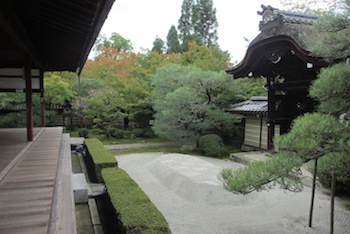
How to get there: Take Kyoto City Bus number 5 to the stop “Nanzenji-Eikando”, which is 5-10 minutes walk. Or take a bike to get around this part of Kyoto, which will save you a lot of time. Open daily 9:00 to 17:00 (entry until 16:00)
Eikando address: 48 Eikandocho, Sakyo Ward, Kyoto, Kyoto Prefecture 606-8445 (Phone:+81 75-761-0007)
9) Nanzen-in (Kyoto)
南禅院庭園 (南禅寺)
Part of temple complex Nanzen-ji, Nanzen-in is much less famous, making it a quiet but very worthwhile garden to visit. The garden dates from the 14th century and is located at the foot of a mountain, revolving around a pond.
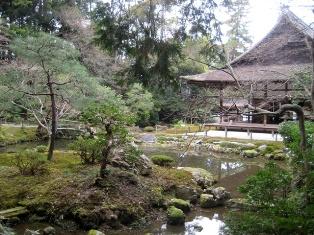
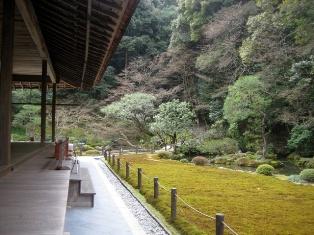
How to get there: Nanzen-in temple is part of the large Nanzen-ji temple complex, easily accessible from Kyoto station with bus 5. The garden is open year round, Mar-Nov: daily 8:40-5; Dec-Feb: daily 8:40-4:30. Entrance fee: 300 Yen. The garden of Nanzen-ji is more crowded, but also recommendable.
Nanzenin address: Nanzenji-Fukuchi-cho, Sakyo-ku, eastern Kyoto (Tel. 075-771-0365)
10) Konchi-in (Kyoto)
金地院
This masterpiece shakkei (borrowed scenery garden) is designed by master gardener Kobori Enshu. Before arriving at the main sight the path leads through a small garden with gorgeous moss, preparing you for the central garden; a spectacular combination of a dry garden, representing the ocean, and a scenery garden, representing the shore line. Note how the mountains in the back are drawn into the design. Surprisingly, the garden is not very crowded and I enjoyed it for over an hour just by myself.
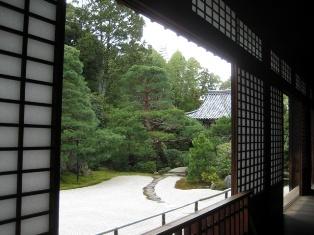
How to get there: Konchi-in is located just west of Nanzen-ji’s main gate in a small side street to the left. The garden is open year round from 8.30-5. Entrance fee: 400 Yen.
Konchiin address: 86-12 Nanzenjifukuchi-cho, Sakyo-ku, Kyoto-shi, Kyoto
11) Shoren-in
青蓮院
Shoren-in dates to the 13th century when it was built as a residence (not as a temple). It was used as a temporary palace after the great Kyoto fire. The garden is absolutely stunning and much less visited than its neighbors.
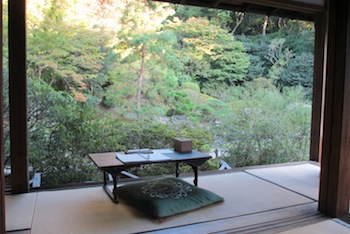
How to get there: Take bus number 5 and get off at Jingu-michi, from which it is a 3 minute walk. Alternatively, its a five minute walk from the Tozai subway line, station Higashiyama. Open from 9am-5pm, last entry 4:30pm.
Shorenin address: 69-1 Sanjobo-cho, Awataguchi, Higashiyama-ku (Tel. 561-2345)
12) Kennin-ji (Kyoto)
建仁寺
Kenninji is the oldest temple in Kyoto (home to the famous panel painting ‘Fu-jin Rai-jin zu’ (wind and thunder gods) and dates from 1202. Located in the Geisha district Gion, the temple grounds are a peaceful retreat. The kare-sansui (dry landscape garden) is gorgeous and one of the largest in Kyoto, definitely recommendable.
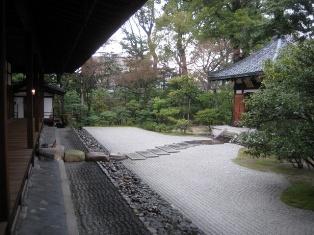
How to get there: Kennin-ji is located just south of Gion, southeast of subway station Gion Shijo. The garden is open from 10:00am-4:00pm (closed from December 28th to 31st). Entrance fee: 500 Yen.
Kenninji address: 584 Komatsu-cho, Higashiyama-ku, Gion, Kyoto (Tel. 075-561-0190)
Official website: www.kenninji.jp
13) Tofukuji
東福寺
The gardens in this temple are beautiful and modern. The current garden was designed by Mirei Shigemori in the 1930s and features several dry gardens.
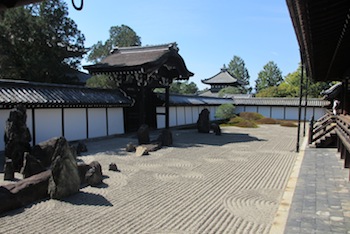
How to get there: Tofukuji temple is located near Tofukuji Station on the JR Nara Line, easily accessible from Kyoto station.
Tofukuji address: 15-778 Hommachi, Higashiyama-ku, Kyoto (Tel. 75-561-0087).
14) Sento Gosho garden (Kyoto)
京都御所
The Sento Gosho palace, originally built in 1630 as a residence to retired emperors, was destroyed and rebuilt several times until a large fire in 1854 (not to be rebuilt again). The enclosed gardens (designed by Kobori Enshu) are still in place and are worth a visit, though entering the park is only possible as part of a rather annoying guided tour (Japanese only). Obtain permission at the Household Agency (on the mid-west part of the Imperial Park, bring your passport); tours are available at 11am and 1.30pm.
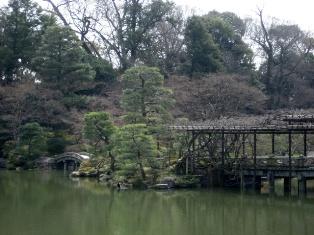
How to get there: The Sento Gosho is located on the eastern part of the Imperial Park. To get there, take the subway Karasuma line to Marutamachi station. The garden is open on weekdays, but permission to enter is required (for more information, see the website below). Entrance fee: free.
Address: N/A (Tel. 03-3213-1111)
Imperial household website: https://sankan.kunaicho.go.jp/english/guide/kyoto.html
15) Shusui-tei (Kyoto)
拾翠亭
Visit this small pond garden (chisen kaiyu-shiki) if you happen to be in the Imperial Palace Park; the Shusuitei tea house (on the western shore) provides the best view of the garden.
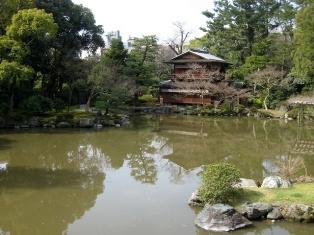
How to get there: Shusui-tei is located in the southwest corner of the Imperial Palace Park, open year round. Entrance fee: free.
16) Daigoji
醍醐寺
This large temple complex is beautifully situated on the hills of Kyoto and consists of several buildings and gardens, all leading to a pond in the back with an iconic bridge and pagoda. This is a famous spot for watching the fall colors.
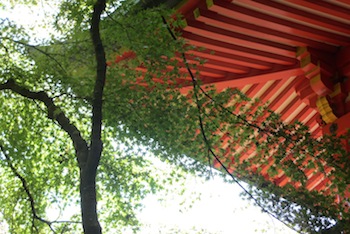
How to get there: The temple is located close to Daigo Station on the Tozai Subway Line.
Daigoji address: 22 Daigohigashiojicho, Fushimi Ward, Kyoto (Tel. 75-571-0002)
Japanese gardens in Nara
Nara can be visited as a day trip from Kyoto and is quite famous for its World Heritage listing of its “Historic Monuments of Ancient Nara”. There are two Japanese gardens that come highly recommended.
Map of the Japanese gardens in Nara
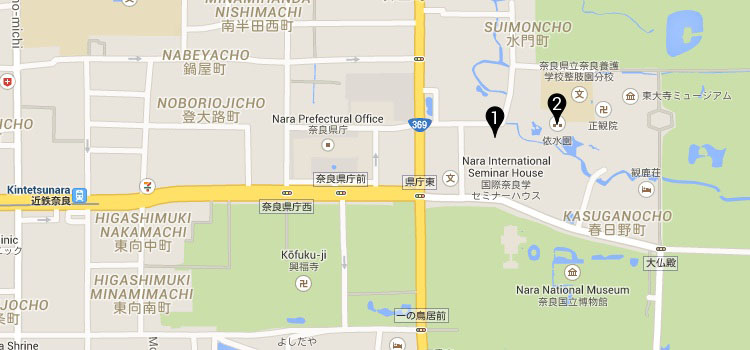
Open this map on Google maps: Japanese gardens in Nara
1) Yoshiki-en
吉城園
Free to foreigners visiting Nara, this garden is privately owned. The present design of the garden dates back to the early 20th century.
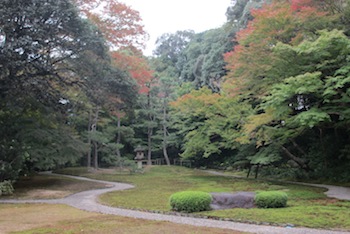
How to get there: Its an easy walk from Nara Kintetsu station.
Yoshikien address: 68 Noboriōji-chō, Nara. Open 9.30am-5pm (Closed Jan to mid-March).
2) Isui-en
依水園
Originally two gardens, Isuien is a stunning strolling garden located centrally in Nara. The garden is large and you can easily spend an hour walking around to appreciate the moss, tea house, ponds and borrowed scenery. On site is a Japanese ceramics museum, included in the entry fee.
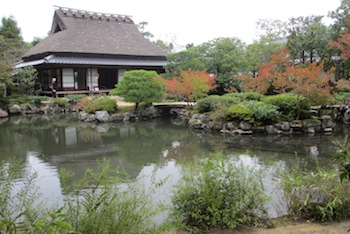
How to get there: Its an easy walk from Nara Kintetsu station.
Isuien address: 74 Suimoncho, Nara. Open 9:30 to 16:30 (entry until 16:00), closed on Tuesdays.

